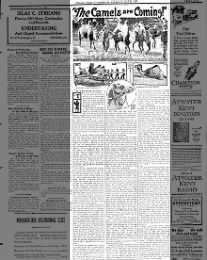Did you know that in the 1850s the American government brought camels to the Southwest to be used by the army and that 50 years later, feral camels were still being spotted in the desert?
In the late 1840s, Major Henry Wayne of the Quartermaster Department suggested the use of camels to the War Department, and in the mid-1850s Secretary of War Jefferson Davis convinced Congress to appropriate money to import the camels as pack animals for the army in the ever expanding West.
Major Wayne and Naval Lieutenant David Dixon Porter sailed to North Africa and the Middle East in 1856 and came home with some camel handlers and a few dozen camels, which were kept at Camp Verde, Texas. A year later, Porter returned for more camels, bringing the total to about 70.
The camel experiment in the Southwest was relatively successful, as camels were hardier than horses, mules, or burros, traveling farther, packing heavier weights, needing water less often, and being able to subsist on the native desert plants. However, the camels tended to spook the other pack animals, and most of the Americans assigned to them never learned to like them or handle them properly.
The camels’ downfall came with the Civil War. The Confederates took over Camp Verde, but when the US government regained control, it had lost interest in the camel experiment, so the animals were sold (though some had died or escaped during the war).
But that wasn’t the end of camels in the Southwest. Up through the early 1900s, there were occasional reports of sightings of feral camels roaming the desert.
Did you know that you can find articles about the army’s camels on Newspapers.com? Below is a selection of a few of the different articles you can find:
- Letter from Major Wayne during his trip to buy the camels
- Account of the camels arriving in the US
- Camels in the army are tested out
- Camels are given a positive review
- Secretary of War recommends buying more camels
- Government puts the camels up for sale
- 14 ex-government camels sent to New York
- Summary of the fate of some of the camels
- Death of what was believed to be the last of the feral camels in 1901
- Camel driver for the government dies in 1903
- Article debating whether feral camels still exist in 1905
Have you heard of the Southwest’s camels? If you want to learn more about them, start a search on Newspapers.com!




Interesting!
yeah
Traveling from Dallas, Tx to Mangum, Ok between 1999 to 2004 we saw camels in a couple places along the road. The one place I remember is by the rest stop between Whicita Falls and Vernon, Tx.
Love the articles, this is “our history” and articles of people, which help us to connect to past relatives, has been so enlightening. The old newspapers are critical with information, I live on the east coast…looking for information on my family from the west coast and though it has taken some time, you had an article about a search of a German Engineer working in Mexico in the 1870’s and had not been seen or heard from for over a year. A body was found on the “trail “…he had been murdered, and he was identified as the engineer.
That man was my Great, great, great grandfather…many in my family could not explain what had happened to him…they thought he had left my ggg grandmother. I love reading these news articles, these written articles solve many mysteries. Thank you.
My ggrandfather, George Washington Speer, served with General Henry Wayne when he was serving as Adjutant-General of the State of Georgia during the Civil War. After he resigned in 1864, my grandfather took his placed and served to the end of the war. My grandfather Wayne Henry Speer, Sr. was named after General Wayne (my grandmother switched the names because she liked the name Wayne better than Henry). I would love to find other newspaper articles about General Wayne and/or my grandfather during the Civil War.
My
great grand father Amasa Clark of Bandera Texas worked with the Camels at Camp Verde
One of the camels brought over for this Army ‘experiment’ was taken home by of the officers. He later gave the camel, named ‘Old Douglas,’ to a fellow officer from Mississippi.
When the WBTS broke out ‘Old Douglas’ was adopted by the 43rd Mississippi Infantry as the regiment’s mascot (his owner gave the camel to the unit). ‘Old Douglas’ served with the regiment in several battles through the Vicksburg Campaign. He wouldn’t stay tied up with the other pack animals and would always break loose. He was allowed to run free, but he never left the camp area.
‘Old Douglas’ carried the regimental band’s instruments and equipment. He was shot and killed by a Union sharpshooter during the Vicksburg Campaign. The men of the 43rd Mississippi were very upset that their mascot was targeted. One the unit’s sharpshooters was able to shoot the Union sniper that had killed ‘Old Douglas.’
Today, in the City Cemetery in Vicksburg, ‘Old Douglas’ is memorized with his comrades from the 43rd Mississippi with a standard grave marker used for Confederate soldiers, ‘Old Douglas’ marker is surrounded by the graves of members of the 43rd Mississippi. His story is told on the back of the marker.
Several times a year a re-enactment group, from Texas, come to the Vicksburg National Military Park to present a living history program about the US Army Camel Corps. One of the camels portrays ‘Old Douglas.’
Old Douglas was a real trooper!
Anyone remember the movie “hawmps”
Yes, that was filmed by MCAS Yuma, AZ, where we were living on at the time.
Very interesting comments. I am 83 yrs old and have heard about the camel experiment many times. Didn’t know that they were assigned to Camp Verde though.
There is a wonderful children’s book available called “exiled” memoirs of a camel by Kathleen karr Narrated by the camel about leaving his homeland and his master and traveling to America to work on railroads and roads in the desert. Such a great book!
My GG Grandfather was George A. Leslie, who bought some camels from the army after the Civil War. He housed them in the “Leslie Camel Barn,” in Dayton, Nevada. The building is now on the historic place registry for the State of Nevada. He rented them out to prospectors. I have a great deal of information about family history, and a bit about camels. Contact me if you are interested.
An interesting article which brought back to me how we used camels in the Trucial Oman Scouts. They were a great asset and have met a few guys who served with the Scouts in S Rhodesia. They used horses and between ourselves we believed they saved quite a few lives and were useful in the respect that they could travel for days with little attention. They were virtually self reliant. Reason for my comment is that I am puzzled as to why they were not used in Iraq and Afghanistan to combat IED’s to some degree. You could travel faster if required and go most places off the beaten track. Just a thought
We also had camels in Canada – brought up from the US, to serve as pack animals on the Caribou trail by prospectors seeking gold in what became the Caribou Gold Rush of the 1860’s. They arrived by paddle wheel boat or barge in the tiny community of Port Douglas, at the north end of Harrison Lakef (about 15 miles from the US border), which was booming.
Thinking of capitalizing on the demand for pack animals in 1862, Lillooet merchant Frank Laumeister decided to bring camels in to transport supplies, shipping the animals from a railway camp in Arizona to San Francisco. Upon arriving in Port Douglas there were twenty-one camels to be taken north. Their smell was very pungent. Smelling the new arrivals the mules and horses of other pack trains would panic, causing a loss of merchandise, supplies and animals. The camels passed along the Douglas Trail, and eventually, were set loose near Kamloops, where the last one was sighted about 1910.
The Colonist (or Victoria Colonist) newspaper, and the Illustratrated London News carried stories, and further information is available at the Lillooet Museum and Archives.
I don’t know how it fits in with this story but I know there were camel barns at the army Benicia Arsenal in Benica California
Check out Benicia Arsenal Camel Barns on Wikipedia.
As a US History teacher, I always try to pull in local history when I can, also human interest stories and unusual things.
In the mid 19th Century the exploration of a road (along what is now I-40) was planned and camels were suggested to be used across the desert in the process. This was approved by Sec of War Jefferson Davis in the Buchanan administration.
Hi Jolly (Hadji Ali) came with 75 camels from the Near East in 1856.
They actually were quite successful, and went all the way to California, but the army disbanded the program.
After the camels were let go, Hi Jolly mined and lived in Quartzsite, AZ. Camels were reported to have been seen wandering in the AZ as late as 1940.
His tomb is there (a pyramid with a camel on top) and very recently, an homage to the camels was placed on a near-by freeway over pass. You can see the camel designs as you drive through on 1-10 just east of Quartzite.
California had several Civil War forts. One still exists (or what remains of the original fort) which is now a wonderful historical site called Drum Barracks in Wilmington, California. The use of camels played a role here as well. The thought was the camels could be used as a pack animal and given the desert area would be ideal for transportation. One trip saw the camels go from Wilmington to Yuma. Camels can be more stubborn than a mule and quite mean at times so the experiment was a failure and the camels were sold off to private parties and zoos. At the Drum Barrack museum one can see the history of the camels that played an interesting role in the history of the Civil War. I highly recommend a trip there for history buffs. Well worth the tour and the collection of Civil War memorablia that the wonderful staff have on display.